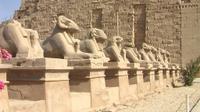Private Tour: 2-Day Luxor Tour from Hurghada
Hurghada, Egypt
Rating: 







Trip Type: Overnight Tours
Duration: 2 days
Spend a night in the ancient city of Luxor to visit all its major attractions. Explore the Valley of the Kings, marvel at Hatshepsut Temple and Luxor Temple, and to top it all off, see the Sound and Light Show at Karnak Temple. There is even time for a horse and carriage ride through the streets of Luxor.
More About This Activity All Overnight Tours →
Spend a night in the ancient city of Luxor to visit all its major attractions. Explore the Valley of the Kings, marvel at Hatshepsut Temple and Luxor Temple, and to top it all off, see the Sound and Light Show at Karnak Temple. There is even time for a horse and carriage ride through the streets of Luxor.
Valley of the Kings
The final resting place of Egypt's rulers from the 18th to 20th dynasty, the Valley of the Kings is home to tombs including the great pharaoh Ramses II and boy pharaoh Tutankhamun.
Hatshepsut Temple
The queen who would-be king, Hatshepsut was a ruler loved by her people but always surrounded in controversy. See her spectacular temple in Luxor's West Bank, one of the best preserved of its kind.
The Sound and Light Show at Karnak
The show starts with a historical introduction covering the birth of the great city of Thebes and erection of the Karnak Temple. The show narrates the glorious achievements of some great Pharaohs as you listen to a magnificent and poetic description of the artistic treasures and great legacy which the Karnak temple encloses.
Karnak Temple
Although badly ruined, no site in Egypt is more impressive than Karnak. It is the largest temple complex ever built by man, and represents the combined achievement of many generations of ancient builders and pharoahs. The Temple of Karnak is actually three main temples, smaller enclosed temples, and several outer temples situated on 247 acres of land.
Luxor Temple
The Temple of Luxor was the center of the most important festival, the festival of Opet. Built largely by Amenhotep III and Rameses II, the temple's purpose was as a setting for the rituals of the festival. The festival was to reconcile the human aspect of the ruler with the divine office.
The final resting place of Egypt's rulers from the 18th to 20th dynasty, the Valley of the Kings is home to tombs including the great pharaoh Ramses II and boy pharaoh Tutankhamun.
Hatshepsut Temple
The queen who would-be king, Hatshepsut was a ruler loved by her people but always surrounded in controversy. See her spectacular temple in Luxor's West Bank, one of the best preserved of its kind.
The Sound and Light Show at Karnak
The show starts with a historical introduction covering the birth of the great city of Thebes and erection of the Karnak Temple. The show narrates the glorious achievements of some great Pharaohs as you listen to a magnificent and poetic description of the artistic treasures and great legacy which the Karnak temple encloses.
Karnak Temple
Although badly ruined, no site in Egypt is more impressive than Karnak. It is the largest temple complex ever built by man, and represents the combined achievement of many generations of ancient builders and pharoahs. The Temple of Karnak is actually three main temples, smaller enclosed temples, and several outer temples situated on 247 acres of land.
Luxor Temple
The Temple of Luxor was the center of the most important festival, the festival of Opet. Built largely by Amenhotep III and Rameses II, the temple's purpose was as a setting for the rituals of the festival. The festival was to reconcile the human aspect of the ruler with the divine office.
Please note: The great pharaoh Ramses II and boy pharaoh Tutankhamun tombs are not included (tickets are available for purchase from your guide).
« Go Back

